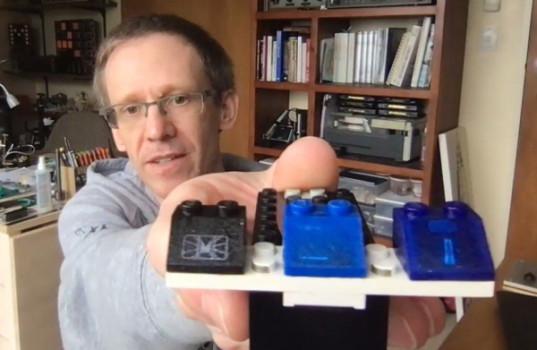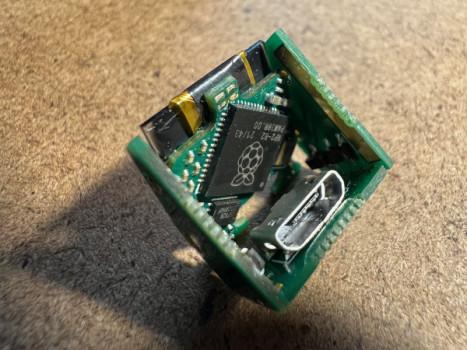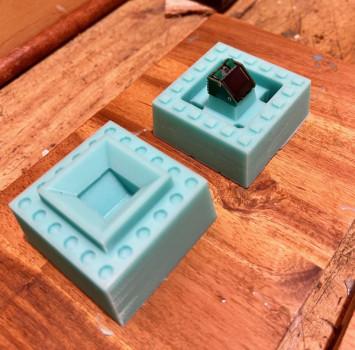
What it requires to develop a little Lego computer system
These aren’t Lego blocks. They’re computer systems that resemble they belong.
James Brown enjoys structure strange display screens. Like animatronic skulls, or mechanical bit-flipping cellular automatons. Or, in this situation, a whole computer system inside a simulated Lego block.
Not simply any type of block, either. I’m discussing the timeless sloped Lego computer systems from our youth spacecrafs, currently wonderfully brought to life. They show phony radar scans, scrolling message, also an interactive tribute to the Death Star trench run targeting computer system that relocates when you touch the revealed Lego studs.
Incredibly, the entire point is powered by real Lego blocks, also — the vintage 9V battery box as well as bricks with electrical contacts that Lego stopped back in the ‘90s. It’s sufficient to power a 72 x 40-pixel OLED display as well as an STM32 microcontroller with a 48MHz Arm Cortex-M0 cpu as well as 16K of flash. And those graphics you see? Apart from Doom, which was an online video clip stream to the block, they’re all procedurally produced. He composed the programs for this small computer system himself.
None of this was Brown’s initial strategy, however in a meeting with The Kupon4U, he makes it seem like it collaborated so well that it’s practically asking to be produced. Yes, I’m telling you there’s a chance you may really touch among these sooner or later.

Last year, the Weta Workshop graphics designer (yes, that Weta Workshop) was simply searching AliExpress when he found some exceptionally little as well as economical 0.42-inch OLED displays. “That’s about the size of a keycap,” he believed. He’d develop a mechanical key-board with a display under each secret, he informed himself, however the task was sluggish going. “I sort of ordered a batch of screens just to have them sitting there making me feel guilty,” he states.
But when a Game Boy for ants shown up on his front door this May, he started to contemplate: suppose each secret had a cpu within, also? Later that exact same day, he instantly recognized he’d currently seen a computer system that dimension. Not a functioning one — an item of Lego.
So he sketched it out, as well as was shocked to see his suggestion may really function. “I spent a little bit of time in Fusion, just kind of looking at where things would fit inside a brick, just making sure it was actually feasible and it only just… you know that screen is really crammed in there, right?” There’s just 0.1mm in between the display as well as the front surface area of the block.
He composed up a motherboard of the optimum dimension that would certainly fit as well as, in a solitary day, put all the standard parts as well as sent his layout to a board supplier on an impulse. He paid simply $40, consisting of shipping, for 5 small boards.
“It was meant to be kind of a throwaway gag; I wasn’t expecting to have to make it particularly manufacturable,” he states.
But when the boards showed up, he couldn’t think exactly how well they appeared. “It’s absolutely insane how cheap and easy this stuff is, you know, to custom-design a new computer,” he states. The hardest component was merely soldering on a pair of battery contacts to the base.
Stick it inside a clear Lego block as well as you’re done, right? No — Brown chose to cast his very own blocks out of clear material, also.
Originally, they were quite unrefined: “It was literally a Lego brick in a Lego pot that I poured silicone on to make the mould and then I just kind of shoved it in there, poured the resin in, put something on top to hold it down, and hoped for the best.” He additionally needed to load the block’s dental caries with soft silicone, so material wouldn’t load the place where the electronic devices required to go.
After his very first video clip went viral, however, he didn’t leave it at that. He ran a set of cables as much as the within each stud as an unrefined touch sensing unit — “the processor counts how long it takes to pull high via a resistor,” he states — as well as coded the X-Wing targeting computer system as well as an Elite ship renderer in C to show their range of exciting low-poly wireframes with a press.
He repainted on a black lacquer to do away with a few of the radiance, also, though he’s really rather satisfied with Lego’s stippled surface. “The texturing on the Lego brick does a really good job of antialiasing.”
And after that, he buckled down.

On Zoom, Brown reveals me the 2nd generation — a brand-new three-dimensional motherboard setting up created to make use of all the room inside the block. It’s obtained integrated battery calls, a USB port for programs as opposed to the old serial debugging pins, as well as capacitive touch equipment baked right into the board itself. He states it can accurately identify a finger moving a whole area over the block.
And since he’s not pleased with just streaming Doom to the STM32 cpu as a video clip over those debugging cables, he simply lately upgraded the whole board to fit a Raspberry Pi RP2040 microcontroller, which could actually play Doom too. And he states there might still suffice room to fit an IMU for movement controls. Me, I can’t wait to see Lego aircrafts flying around an area with a working attitude gyro.

And currently, the solution to the concern you’ve all been awaiting: will he take your cash for among these blocks?
He isn’t ruling it out — however certainly not yet.
“This is really not in any state to suggest that this is going to be a product; I would not want people to get in touch with me suggesting money for a pre-order, because that is not going to happen,” he states.

He does strategy to create a few of them for close friends to dabble with, however he’s simply not yet certain concerning production, qualification, licensing, as well as most of all, the true blessing or disfavor of The Lego Group itself. Clearing it with Lego, or a minimum of “making sure that I’m not going to get the weight of Lego on top of me” is the hardest issue, he states. “There’s a difference between doing something that is acceptable and being able to actually fight if they decide to throw their weight around.” Obviously, he doesn’t intend to offer any type of blocks that essentially claim “Lego” on their studs — his Friday tweet reveals a block that dumps the logo design.
He additionally wishes to locate as well as fit a rechargeable battery prior to he’d think about production, since not every person has late ‘80s / early ‘90s Lego electronics boards just sitting in a bin.
“I’m seeing exactly how much I can opt for it,” he states.
If you’re reading this, Lego, I regards wish you’ll allow him copulate. When you collaborate with the area, the results are amongst the most effective items you’ve ever before made.








